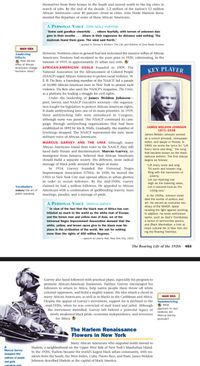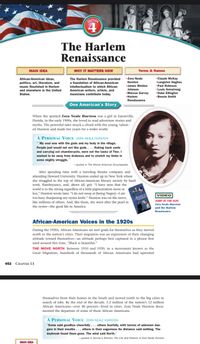Question
What do the Great migration and the growth of the NAACP and UNIA reveal about the African-American experience during the twenties.

Transcribed Image Text:themselves from their homes in the South and moved north to the big cities in
search of jobs. By the end of the decade, 5.2 million of the nation's 12 million
African Americans-over 40 percent-lived in cities. Zora Neale Hurston docu-
mented the departure of some of these African Americans.
A
A PERSONAL VOICE ZORA NEALE HURSTON
"Some said goodbye cheerfully ... others fearfully, with terrors of unknown dan-
gers in their mouths... others in their eagerness for distance said nothing. The
daybreak found them gone. The wind said North."
-quoted in Sorrow's Kitchen: The Life and Folklore of Zora Neale Hurston
MAIN IDEA
Analyzing
Effects
A How did the
influx of African
Americans change
Northem cities?
However, Northern cities in general had not welcomed the massive influx of African
Americans. Tensions had escalated in the years prior to 1920, culminating, in the
summer of 1919, in approximately 25 urban race riots. A
AFRICAN-AMERICAN GOALS Founded in 1909, The
KEY PLAYER
National Association for the Advancement of Colored People
(NAACP) urged African Americans to protest racial violence. W.
E. B. Du Bois, a founding member of the NAACP, led a parade
of 10,000 African-American men in New York to protest such
violence. Du Bois also used the NAACP's magazine, The Crisis,
as a platform for leading a struggle for civil rights.
Under the leadership of James Weldon Johnson-
poet, lawyer, and NAACP executive secretary-the organiza-
tion fought for legislation to protect African-American rights.
It made antilynching laws one of its main priorities. In 1919,
three antilynching bills were introduced in Congress,
although none was passed. The NAACP continued its cam-
paign through antilynching organizations that had been
established in 1892 by Ida B. Wells. Gradually, the number of
lynchings dropped. The NAACP represented the new, more
JAMES WELDON JOHNSON
1871-1938
James Weldon Johnson worked
as a school principal, newspaper
editor, and lawyer in Florida. In
1900, he wrote the lyrics for "Lift
Every Voice and Sing." the song
that became known as the black
national anthem. The first stanza
begins as follows:
militant voice of African Americans.
MARCUS GARVEY AND THE UNIA Although many
African Americans found their voice in the NAACP, they still
faced daily threats and discrimination. Marcus Garvey, an
immigrant from Jamaica, believed that African Americans
should build a separate society. His different, more radical
message of black pride aroused the hopes of many.
In 1914, Garvey founded the Universal Negro
Improvement Association (UNIA). In 1918, he moved the
UNIA to New York City and opened offices in urban ghettos
in order to recruit followers. By the mid-1920s, Garvey
claimed he had a million followers. He appealed to African
"Lift every voice and sing
Till earth and heaven ring.
Ring with the harmonies of
Liberty:
Let our rejoicing rise
High as the listening skies,
Vocabulary
Let it resound loud as the
oratory: the art of Americans with a combination of spellbinding oratory, mass
rolling sea.
public speaking
meetings, parades, and a message of pride.
In the 1920s, Johnson strad-
dled the worlds of politics and
art. He served as executive sec-
A PERSONAL VOICE MARCUS GARVEY
"In view of the fact that the black man of Africa has con-
retary of the NAACP, spear-
heading the fight against lynching.
In addition, he wrote well-known
works, such as God's Trombones,
a series of sermon-like poems,
and Black Manhattan, a look at
black cultural life in New York dur-
ing the Roaring Twenties.
tributed as much to the world as the white man of Europe,
and the brown man and yellow man of Asia, we of the
Universal Negro Improvement Association demand that the
white, yellow, and brown races give to the black man his
place in the civilization of the world. We ask for nothing
more than the rights of 400 million Negroes."
-speech at Liberty Hall, New York City, 1922
The Roaring Life of the 1920s 453
Garvey also lured followers with practical plans, especially his program to
promote African-American businesses. Further, Garvey encouraged his
followers to return to Africa, help native people there throw off white
colonial oppressors, and build a mighty nation. His idea struck a chord in
many African Americans, as well as in blacks in the Caribbean and Africa.
Despite the appeal of Garvey's movement, support for it declined in the Summarizing
mid-1920s, when he was convicted of mail fraud and jailed. Although B What
the movement dwindled, Garvey left behind a powerful legacy of approach to race
newly awakened black pride, economic independence, and reverence Marcus Garvey
MAIN IDEA
relations did
for Africa. 8
promote?
The Harlem Renaissance
Flowers in New York
Many African Americans who migrated north moved to
Harlem, a neighborhood on the Upper West Side of New York's Manhattan Island.
In the 1920s, Harlem became the world's largest black urban community, with res-
Marcus Garvey
designed this
uniform of purple
idents from the South, the West Indies, Cuba, Puerto Rico, and Haiti. James Weldon
Johnson described Harlem as the capital of black America.
and gold,
complete with

Transcribed Image Text:SECTION
4
The Harlem
Renaissance
MAIN IDEA
WHY IT MATTERS NOW
Terms & Names
Zora Neale
Hurston
The Harlem Renaissance provided
African-American ideas,
politics, art, literature, and
music flourished in Harlem
and elsewhere in the United
•Claude McKay
•Langston Hughes
a foundation of African-American
intellectualism to which African-
James Weldon
•Paul Robeson
American writers, artists, and
musicians contribute today.
Johnson
Marcus Garvey
Harlem
•Louis Armstrong
Duke Ellington
•Bessie Smith
States.
Renaissance
One American's Story
When the spirited Zora Neale Hurston was a girl in Eatonville,
Florida, in the early 1900s, she loved to read adventure stories and
myths. The powerful tales struck a chord with the young, talent-
ed Hurston and made her yearn for a wider world.
A PERSONAL VOICE ZORA NEALE HURSTON
*My soul was with the gods and my body in the village.
People just would not act like gods.... Raking back yards
and carrying out chamber-pots, were not the tasks of Thor. I
wanted to be away from drabness and to stretch my limbs in
some mighty struggle.
-quoted in The African American Encyclopedia
After spending time with a traveling theater company and
attending Howard University, Hurston ended up in New York where
she struggled to the top of African-American literary society by hard
work, flamboyance, and, above all, grit. "I have seen that the
world is to the strong regardless of a little pigmentation more or
less," Hurston wrote later. "I do not weep at (being Negro)-I am
too busy sharpening my oyster knife." Hurston was on the move,
like millions of others. And, like them, she went after the pearl in
the oyster-the good life in America.
VIDEO
AMERICAN
JUMP AT THE SUN:
Zora Neale Hurston
and the Harlem
Renaissance
African-American Voices in the 1920s
During the 1920s, African Americans set new goals for themselves as they moved
north to the nation's cities. Their migration was an expression of their changing
attitude toward themselves-an attitude perhaps best captured in a phrase first
used around this time, "Black is beautiful."
THE MOVE NORTH Between 1910 and 1920, in a movement known as the
Great Migration, hundreds of thousands of African Americans had uprooted
452 CHAPTER 13
themselves from their homes in the South and moved north to the big cities in
search of jobs. By the end of the decade, 5.2 million of the nation's 12 million
African Americans-over 40 percent-lived in cities. Zora Neale Hurston docu-
mented the departure of some of these African Americans.
A PERSONAL VOICE ZORA NEALE HURSTON
"Some said goodbye cheerfully ... others fearfully, with terrors of unknown dan-
gers in their mouths ... others in their eagerness for distance said nothing. The
daybreak found them gone. The wind said North."
-quoted in Sorrow's Kitchen: The Life and Folklore of Zora Neale Hurston
MAIN IDEA
Expert Solution
arrow_forward
Introduction
The 1920s is also known as the “Jazz Age” because of its cultural and artistic advancements. America witnessed a major shift with the advent of Industrialization.
Trending nowThis is a popular solution!
Step by stepSolved in 3 steps
